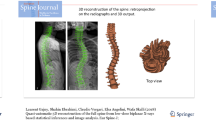Abstract
Complex deformities of the spine, like scoliosis, are evaluated more precisely using stereo-radiographic 3D reconstruction techniques. Primarily, it uses six stereo-corresponding points available on the vertebral body for the 3D reconstruction of each vertebra. The wireframe structure obtained in this process has poor visualization, hence difficult to diagnose. In this paper, a novel method is proposed to improve the visibility of this wireframe structure using a deformation of a generic spine model in accordance with the 3D-reconstructed corresponding points. Then, the geometric inferences like vertebral orientations are automatically extracted from the radiographs to improve the visibility of the 3D model. Biplanar radiographs are acquired from five scoliotic subjects on a specifically designed calibration bench. The stereo-corresponding point reconstruction method is used to build six-point wireframe vertebral structures and thus the entire spine model. Using the 3D spine midline and automatically extracted vertebral orientation features, a more realistic 3D spine model is generated. To validate the method, the 3D spine model is back-projected on biplanar radiographs and the error difference is computed. Though, this difference is within the error limits available in the literature, the proposed work is simple and economical. The proposed method does not require more corresponding points and image features to improve the visibility of the model. Hence, it reduces the computational complexity. Expensive 3D digitizer and vertebral CT scan models are also excluded from this study. Thus, the visibility of stereo-corresponding point reconstruction is improved to obtain a low-cost spine model for a better diagnosis of spinal deformities.








Similar content being viewed by others
References
Seoud L, Cheriet F, Labelle H, Dansereau J: A novel method for the 3D reconstruction of scoliotic ribs from frontal and lateral ladiographs. IEEE Trans Biomed Eng 58:5, 2011
Gamage P, Xie SQ, Delmas P: Diagnostic radiograph based 3D bone reconstruction framework: Application to the femur. J Comput Med Imaging Graph 35:427–437, 2011
Boisvert J, Cheriet F, Pennec X: Articulated Spine Models for 3D Reconstruction from Partial Radiographic Data. IEEE Trans Biomed Eng 55:11, 2008
Andre B, Dansereau J, Labelle H: Optimized vertical stereo base radiographic setup for the clinical three dimensional reconstruction of the human spine. J Biomech 27:1023–1035, 1994
Aubin CE, Dansereau JF: Morphometric evaluations of personalized 3D reconstructions and geometric models of the human spine. J Med Biol Eng Comput 35:611–618, 1997
Mitton D, Landry C, Verson S, Skalli WF, de Guise J: 3D reconstruction method from biplanar radiography using non-stereo corresponding points and elastic de-formable meshes. J Med Biol Eng Comput 38:133–139, 2000
Mitulescu A, Skalli W, et al: Three-dimensional surface rendering reconstruction of scoliotic vertebrae using a non-stereo-corresponding points technique. Eur Spine J 11(4):344–352, 2002
Pomero V, Mitton D, Laporte S, de Guise J, Skalli W: Fast accurate stereo-radiographic 3D reconstruction of the spine using a combined geometric and statistic model. J Clin Biomech 19:240–247, 2004
Humbert L, de Guise J, Aubert B, Godbout B, Skalli W: 3D reconstruction of the spine from biplanar X-rays using parametric models based on transversal and longitudinal inferences. J Med Eng Phys 31:681–687, 2009
Dumas R, Blanchard B, Carlier R, et al: A semi-automated method using interpolation and optimization for the 3D reconstruction of the spine from bi-planar radiography. J Med Biol Eng Comput 46:85–92, 2008
Zhang J, Lv L, et al: 3D reconstruction of the spine from biplanar radiographs based on contour matching using the Hough transform. IEEE Trans Biomed Eng 60:7, 2013
Anitha H, Prabhu GK: Automatic quantification of spinal curvature in scoliotic radiograph using image processing. J Med Syst 36:1943–1951, 2012
Panjabi MM, Takata K, et al: Thoracic human vertebrae – Quantitative three-dimensional anatomy. Spine 16:889–901, 1991
Dansereau J, Beauchamp A, de Guise, Labelle H: Three-dimensional reconstruction of the spine and rib cage from stereoradiographic and imaging techniques. In: 16th Conference of the Canadian Society of Mech Eng, Toronto, 1990, 2: 61–64
Kadoury S, Cheriet F, Laporte C, Labelle H: A versatile 3D reconstruction system of the spine and pelvis for clinical assessment of spinal deformities. J Med Biol Eng Comput 45:591–602, 2007
Delorme S, Petit Y, de Guise J, et al: Assessment of the 3D reconstruction and high-resolution geometrical modeling of the human skeletal trunk from 2-D radiographic images. IEEE Trans Biomed Eng 50:8, 2003
Abdel Aziz, Karara: Direct linear transformation from comparator coordinates into object space coordinates in close-range photogrammetry. Proceedings of the Symposium on Close-Range Photogrammetry. Falls Church, VA: American Society of Photogrammetry, 1971 pp. 1–18
Bates DM, Watts DG: Nonlinear regression and its applications. Wiley, New York, 1988
Kumar S, Prabhakar Nayak K, Hareesh KS: Semiautomatic method for segmenting pedicles in vertebral radiographs. Proc ICCCS’12, Procedia Technol, Elsevier 6:39–48, 2012. doi:10.1016/j.protcy.2012.10.006
Mukhopadhyay S, Chanda B: An edge preserving noise smoothing technique using multiscale morphology. J Signal Process 82:527–544, 2002
Kass M, Witkin A, Terzopoulos D: Snakes: active contour models. Int J Comput Vis 1:321–331, 1998
Gonzalez R, Woods R: Digital image processing, 2nd edition. Addison Wesley, 1992, p. 414 – 428
Hough: Method and means for recognizing complex patterns. Patent 3069654, USA 1962
Berthonnaud E, Dimnet J: Analysis of structural features of deformed spines in frontal and sagittal projections. J Comput Med Imaging Graph 31:9–16, 2007
Acknowledgments
The authors would like to acknowledge the Department of Science and Technology (DST), Government of India. This project is funded under a SERB-DST, Fast Track Scheme for Young Scientists. The authors also recognize the help extended by the faculty, Kasturba Medical College, Manipal, in data acquisition and expert opinion.
Author information
Authors and Affiliations
Corresponding author
Ethics declarations
The local ethical committee has approved this study.
Rights and permissions
About this article
Cite this article
Kumar, S., Nayak, K.P. & Hareesha, K.S. Improving Visibility of Stereo-Radiographic Spine Reconstruction with Geometric Inferences. J Digit Imaging 29, 226–234 (2016). https://doi.org/10.1007/s10278-015-9841-1
Published:
Issue Date:
DOI: https://doi.org/10.1007/s10278-015-9841-1




